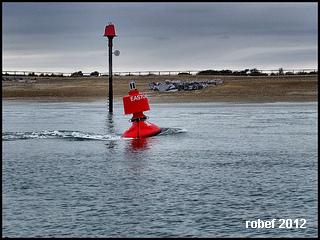Introduction... what's this tide section about ?
Return to "tides" section
Introduction and preamble...
If you live anywhere in the UK you will not be too far from tidal waters. Whether you walk your dog along the beach, go kayaking, windsurfing, kite surfing, dinghy sailing or boating of any kind... sooner or later you're going to have to learn to live with the effects of the tide.
For many new to boating, learning to deal with the tides is one of the first things to be mastered.
Unless you own a very fast boat (and are happy to waste fuel), you will need to work with the tides. All leisure activities carried out on the beach or nearby require at least a cursory understanding of the tides.

The tidal component of most interest to those on the shore is the height of the tide. Whether it's coming in or going out, how high it is likely to be.. being caught out by a rising tide on an isolated part of the beach or coastline can lead to tragedy. The height of the tide is also of great importance to the thousands of boaters who choose to keep their boats in tidal harbours, estuaries and rivers. Boats that live on drying moorings have a limited opportunity to get out to sea, likewise boats that lie afoat in tidal marinas but have to lock in and out.
Living near the shore, or alongside a tidal river or estuary can also require a knowledge of the tides. Flooding can occur at exceptionally high " high waters", (especially in conjunction with unusual metrological conditions) it is wise to be prepared.
View this years tide tables for 400+ locations:
The other tidal component consists of tidal streams, which are of less concern to the landlubber, but of great concern to those who put to sea in boats. With the tide rushing, as shown in the picture below....

What chance would you have of pushing against that in your boat, let alone trying to swim in it.
This section of the website is being developed to gather together all the information we already have (and masses more information we are currently gathering)... about tides.
This section will end up containing full explanations of how the tides work, tidal flow atlases covering the UK and surrounding areas, official tide tables covering are over 400 harbours and tide stations in the UK and Ireland, and unofficial tide tables covering the nearby continent. Eventually it will also contain unique passage planning information concerning how to make best use of the tides.
Some of the information we will be presenting (in particular official UK tide tables for over a year ahead) will not have been seen online before.
Where possible we will be sourcing our information from the most authoritative source in the UK, the Admiralty. UK tide tables and tidal flow atlases will be based on their official information. Explanations and sailing directions will be based on material from the Admiralty Manual of Seamanship, and Admiralty Sailing Directions (in particular much older volumes, which have certain information of far more relevance to those under sail).
Keep an eye on this section over the next few months.


